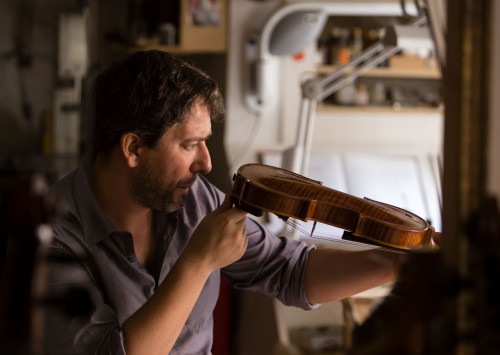Before Guaraldi came to the workshop in Corte Botera there was certainly plenty of music listened to with his family and a lifetime love of manual work, then the dazzling meeting with a self-taught luthier in the 1990s that led him to choose the luthier’s school in Milan. This was followed by years of work and study alongside expert craftsmen on the Veneto mainland, a workshop of his own in the Treviso hills then his return to Venice with an established network of national and especially international relations and associations.
Because being a ‘luthier in Venice’, to Guaraldi, Venetian by birth, is not without meaning. The city was the actual or elected home of some of the most important masters ever. Martin Kaiser, Matteo Goffriller and Domenico Montagnana lived and worked here in the golden age of the eighteenth century, when Pietro Guarneri also worked in Venice, probably the brother of Giuseppe Guarneri, called del Gesù, whose violins are now sold at international auctions for millions of euros.
From the sixteenth to the eighteenth century, the luthiers’ workshops in Venice employed at least a hundred masters, craftsmen and assistants. Organised within the guild of the Marzeri, the Venetian luthiers, inventors of the protoviolin, created instruments that were in demand and exported all over Europe.
The work of the luthier has certainly changed for example graphic design software are now used in the design of a violin but in Guaraldi’s studio a little of the same atmosphere that must have pervaded the Venetian workshops of old can still be felt, perhaps partly because of the smell of the precious seasoned maple and fir, woods tracked down in the Val di Fiemme and Montenegro and selected on the basis of the balance between elasticity, weight and types of vibration.
‘The magic is that of the musician who plays;in the work of the luthier there is much philosophy but there also has to be the certainty given by a perfect mechanical structure’ explains Guaraldi. And so, in addition to the search for the right wood, there are mathematical calculations, the proportions between nodes and antinodes, the external convexity, the choice of accessories and infinite variables that the luthier harmonises
and adjusts from the time he begins working the wood through to when the instrument is ready for its destiny. It is a stringed instrument that carries Guaraldi’s signature not so much or not only on the internal scroll, but especially in its whole: the drop silhouette of the heads sculpted in a particular way, the purfling and the points, the edge fluting and the ‘f ’ holes in a style similar to that of Eugenio Degani, a great nineteenth-century luthier. A form that is always evolving.
The Venetian luthier also follows the life of his creations after they have left his workshop. At times it is the violin or viola that comes back to the workshop for an inspection or check, but often it is Guaraldi himself who rediscovers, in some theatre in Italy or Europe, one of his violins born from maple and fir woods in the little Corte Botera workshop.


